Extracellular vesicles from saxitoxin-producing strains of the cyanobacterium Raphidiopsis raciborskii and investigation of their potential allelopathic effect

Extracellular vesicles from saxitoxin-producing strains of the cyanobacterium Raphidiopsis raciborskii and investigation of their potential allelopathic effect
do Nascimento, C. P.; Vilar, M. C. P.; Bisch, P. M.; Pacheco, A. B. F.
AbstractRaphidiopsis raciborskii is a filamentous cyanobacterium with global distribution in tropical and temperate climates. Toxic strains isolated in Latin America produce saxitoxins (STXs), which are neurotoxins that block voltage-gated ion channels in cells. This cyanobacterium can exert allelopathic effects on other phytoplankton species in response to resource competition through the secretion of substances that impair the target-cell physiology. Extracellular vesicles (EVs) constitute a secretion system that can transport biologically active molecules to distant targets in a protected, concentrated and targeted way. However, the role of EVs in cyanobacterial biology is poorly understood. We aimed to characterize R. raciborskii EVs and test whether this extracellular fraction or other exudate fractions contribute to its allelopathic effect. Exudates from two STX-producing R. raciborskii strains (T3 and CY-10) were subjected to filtration and divided into vesicular fractions (VF, >100 kDa, with EVs), which were concentrated by ultracentrifugation, and dissolved fractions (DF, <100 kDa, no EVs). Characterization of the VF through nanoparticle tracking analysis and transmission electron microscopy revealed spheric structures with diameters of 100-200 nm. Ratios of the number of EVs/cell were estimated as 21.54 {+/-} 1.33 for T3 and 8.79 {+/-} 0.38 for CY-10. The STX content of exudate fractions was determined by ELISA. Total extracellular STX concentrations (STX + neosaxitoxin (neoSTX)) were 170.64 ({+/-}15.43) pg.mL-1 for T3 and 913.84 ({+/-}226.87) pg.mL-1 for CY-10 and these values were similar to those of the DF (<100 kDa fraction). In the VF, STX concentrations were approximately 103 - 104 times lower. The estimation of toxin quotas (per biovolume) resulted in values 20-40 times lower in EVs (0.27{+/-}0,09 ng.mm-3 for T3 and 1.81{+/-}0.49 ng.mm-3 for CY-10) than in cells (13.05 {+/-}2.16 ng.mm-3 for T3 and 33.65 {+/-}7.31 ng.mm-3 for CY-10). A shift in the predominant analog between compartments was observed, with neoSTX prevailing in cells and STX in EVs. The CY-10 strain exhibited higher toxin concentrations than T3 in the VF, DF, total extracellular fraction and cellular fraction. The allelopathic effect of R. raciborskii exudate fractions was tested on the green algae Monoraphidium capricornutum. The total extracellular fraction and the DF equally inhibited M. capricornutum growth and photosynthesis, but the VF had no effect. Thus, the effect can be attributed to dissolved allelopathic compounds <100 kDa. These results open new opportunities to further investigate the role of EVs in the ecophysiology of R. raciborskii.